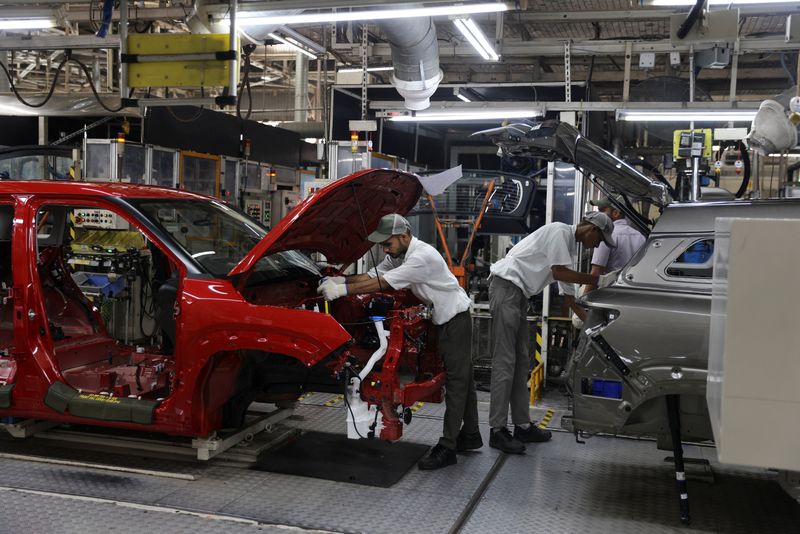By John Kemp
LONDON (Reuters) -India has been the world’s fastest-growing major economy in the last two years and is forecast to retain the top spot in 2024 as the urbanisation and industrialisation process reaches the rapid take-off phase.
Real gross domestic product is forecast to increase more than 6% in both 2023 and 2024, according to the International Monetary Fund (“World economic outlook”, IMF, October 2023).
Compound annual growth will be slightly faster than China (4-5%), twice as fast as the world economy as a whole (3%), and four times faster than in the advanced economies (1.5%).
India’s economy and demographics resemble China’s between the late 1990s and early 2000s, indicating there could be two more decades of rapid sustained growth ahead as well as an enormous associated rise in energy use: * Real gross domestic product per capita at purchasing powerparity had risen to $7,100 in 2022, a rate China first reachedin 2007/08 (“World development indicators”, World Bank, 2023). * Median population age has increased but is still low at27.9 years, which China reached in 1998 (“World populationprospects”, United Nations Population Division, 2022). * Population growth averaged 1.1% per year over the 10 yearsfrom 2012 to 2022, similar to China’s over the ten years from1988 to 1998 (“World population projects”, United NationsPopulation Division, 2022). * The share of the population living in urban areas isestimated to have reached 35% in 2022, a level reached in Chinaaround 2000 (“World urbanisation prospects”, United NationsPopulation Division, 2018). * Energy consumption reached 26 gigajoules per person in2022, a rate China reached in the early 1990s (“Statisticalreview of world energy”, Energy Institute, 2023). * Total oil consumption climbed to 237 million metric tonsin 2022, which China first reached in 2001 (“Statistical reviewof world energy”, Energy Institute, 2023). * Severe air pollution in Delhi and other major urban areasresembles China’s northern cities in the 1990s and 2000s, whenpollution was estimated to cut life expectancy by up to fiveyears.
There are important differences between the two economies, including climate (China’s cities are at much higher latitudes so more energy is needed for heating) and relations between state-owned firms and the private sector.
But there are also important similarities, including a large rural population ready to migrate to urban areas in pursuit of better paid work and a large potential to industrialise by catching up with more advanced economies.
Chartbook: India population, economy and energy use
RAPID TAKE OFF
India is entering the central take-off portion of the S-curve when urbanisation, industrialisation, household incomes and energy consumption increase most rapidly, usually for several decades at a time.
Real incomes are still less than half the level in China and a sixth of the average for the advanced economies in the Organization for Economic Cooperation and Development (OECD), so there is enormous catch-up potential.
For structural reasons, India is likely to remain the world’s fastest-growing economy throughout much of the next 10-20 years, provided it can avoid major policy errors or other negative shocks.
The combination of fast-growth in an already very large economy ensures it will be one of the largest if not the largest contributors to global growth throughout the 2020s and 2030s.
If India follows the same trajectory as every large country before it, urbanisation, industrialisation and rapidly increasing incomes, especially in the middle class, will drive an enormous increase in demand for energy services.
India’s expanding middle class will demand much more power for air-conditioning, lighting and appliances as well as more liquid fuels and/or electricity for domestic and foreign travel.
India’s primary energy consumption per person is less than a quarter of China’s and one-sixth of the average in the OECD economies, again implying an enormous potential to increase as the gap narrows.
With the United States, China and the European Union, India is one of the four key building blocks for any projection about energy consumption, fossil fuel use, and emissions at global scale through mid-century.
No two countries ever follow exactly the same trajectory of economic development and energy consumption; India will follow its own path and have to deal with its own specific challenges.
But China’s rapid, sustained and massive growth over the 2000s and 2010s, with its roots in the reform and opening of the 1980s and 1990s, provides an indication of the direction and scale of the changes to come.
Related column:

- China and India struggle to curb fossil fuels (October 19, 2023)
John Kemp is a Reuters market analyst. The views expressed are his own. Follow his commentary on X: https://twitter.com/JKempEnergy